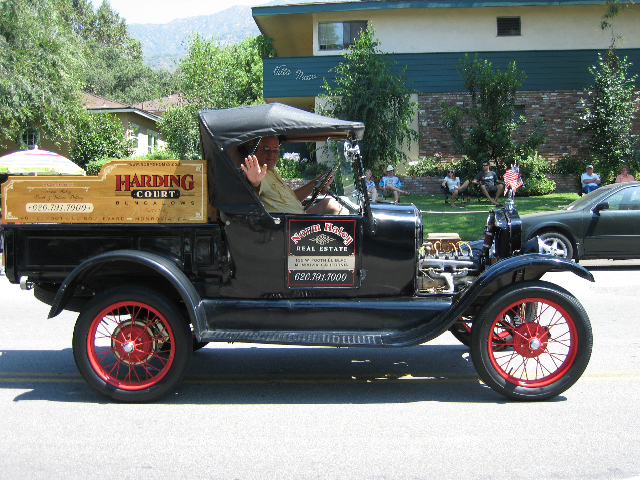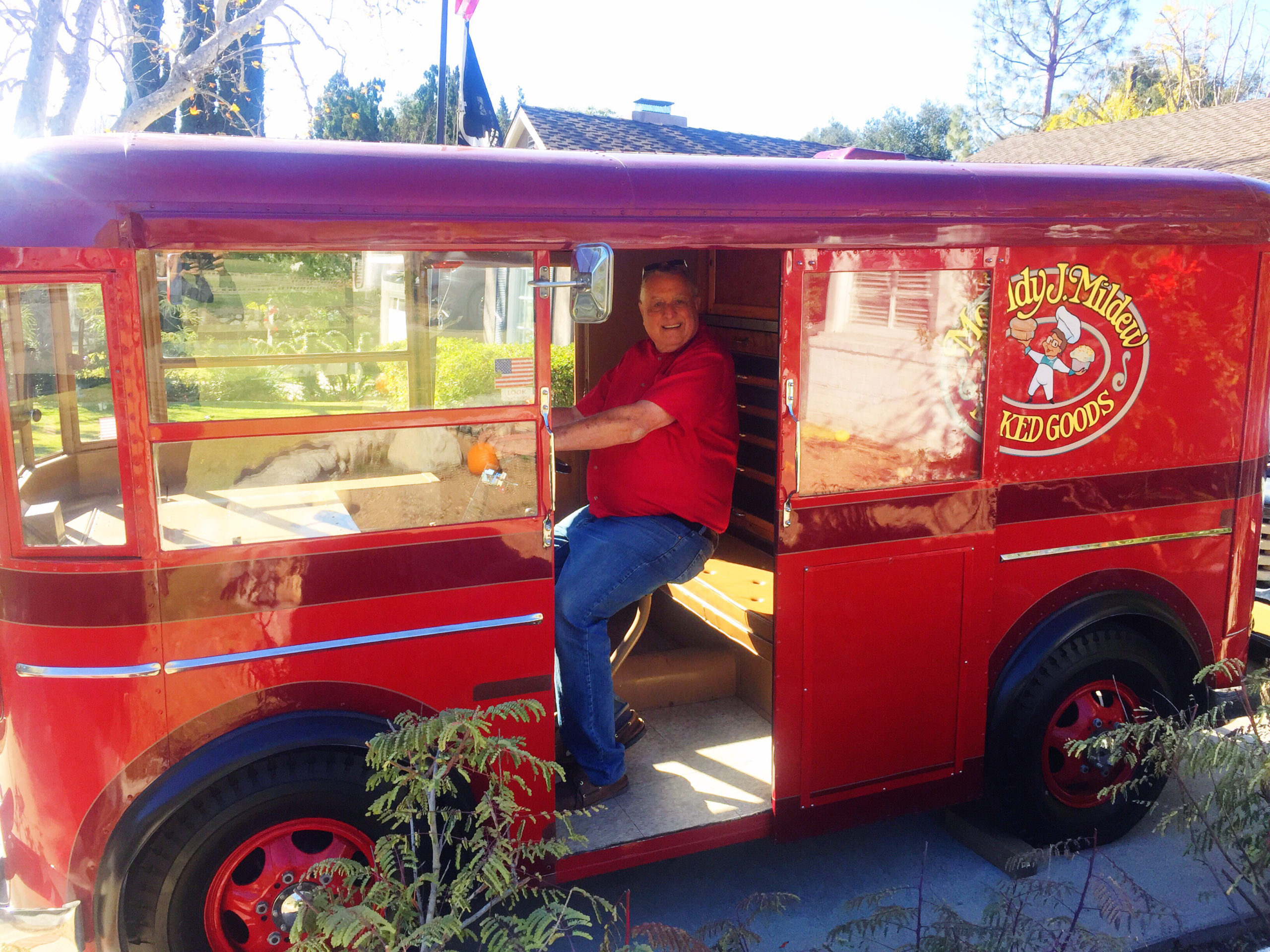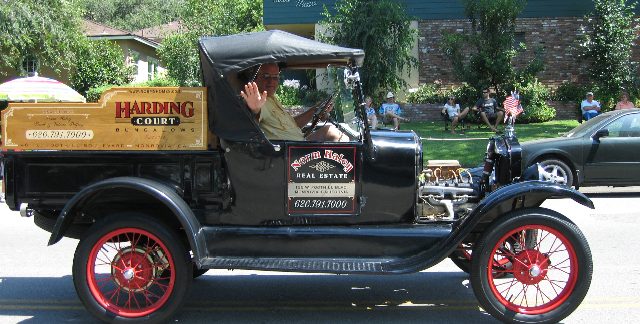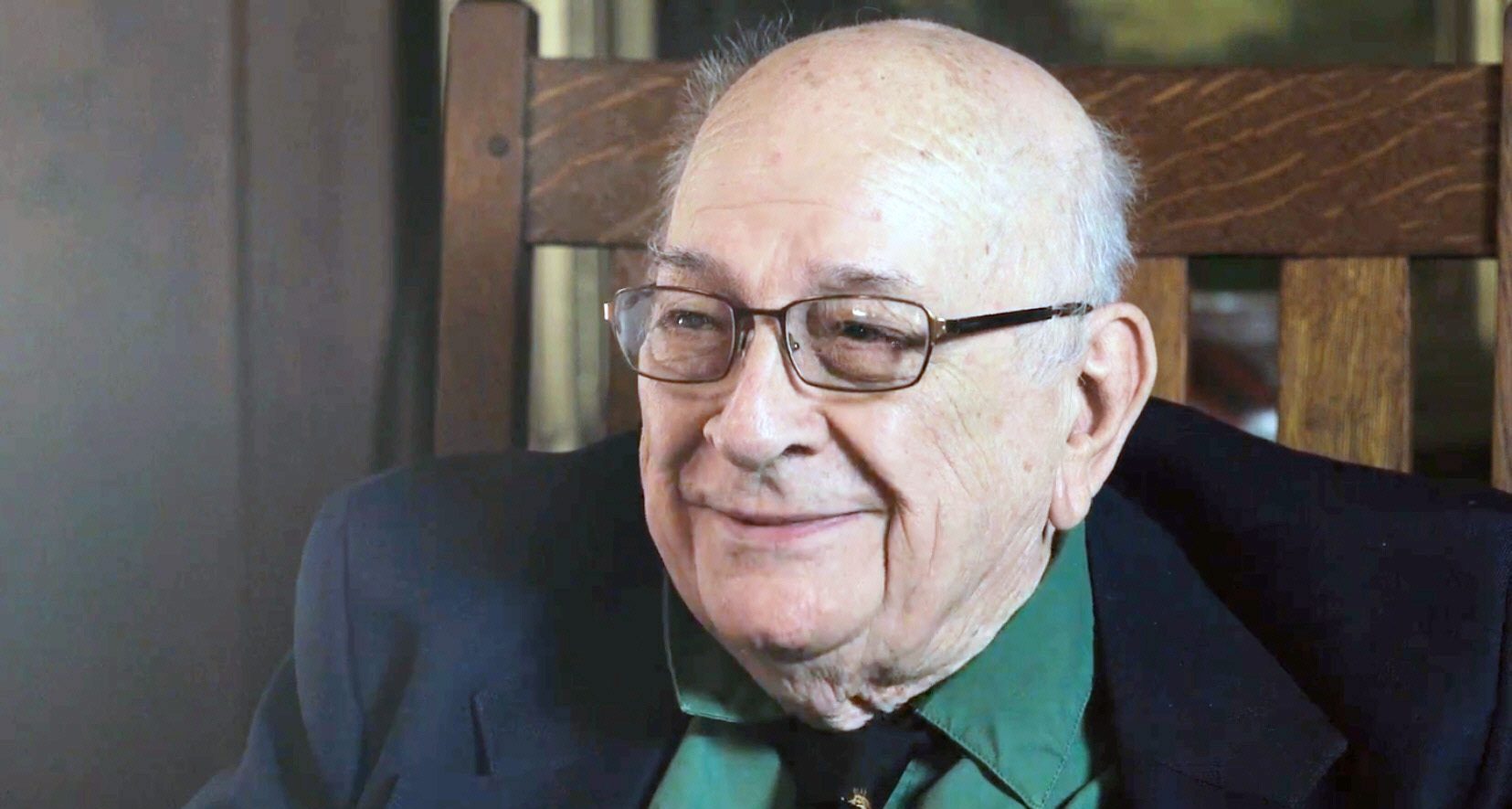
By May S. Ruiz
In ‘Ragtime: The Musical,’ a Ford Model T precipitates all the ensuing action that takes place; so it was important for the car to be on stage. Fortunately, Christopher Cook, Pasadena Playhouse’s Production Manager, didn’t have too far to go to find one. Altadenan Norm Haley, a real estate broker, is an avid collector of Model Ts and he graciously lent one of his cars.
Danny Feldman, Producing Artistic Director, can’t wait to show off the car they were able to borrow for the show. After I interview him at in his office, he walks me down to the stage where the Ford Model T is set on rollers, all ready to make its debut. “Norm drove this car up to The Playhouse and you should have seen us – we were jumping with excitement!,” he relates with the giddiness of a child in a toy store. “Doesn’t it look amazing?! Someone has to write about him and the car.”
And so on a cold and gray morning, a few days into ‘Ragtime’s’ run, Norm Haley and I meet at the theatre’s library to chat about how his Model T became part of The Playhouse’s biggest production, his collection, and his fascination with cars.
“I got a phone call from The Playhouse asking me what Model Ts I had,” Haley begins. “After they described what they needed, I said yes, I have something that looks like that and it’s garaged somewhere close to The Playhouse. We met, they looked at it, they photographed it, and they decided they wanted to use it.”
Haley’s interest in automobiles came from his dad, who, in the early 1960s, worked on cars. He bought his first car – a Jeep – when he was 14, before he could even drive. He and his dad worked on it for a couple of years until he was old enough to take it on the road.
Collecting Ford Model Ts happened quite by accident, though. Haley recalls, “Back in 1976 or 1977, I had sold a house up in Altadena and I was sitting at the breakfast table with the couple. We were getting ready to sign the sale papers when the wife looked up and said to her husband, ‘I’m not signing these papers until you agree to get rid of some stuff.’ And one of the ‘stuff’ was a 1926 Canadian Model T Touring car. As you probably surmised, I ended up selling their house and owning the car.
“Now I own ten Model Ts, with some of the last serial numbers they made. I have every model they built in 1926-27, which were called The Improved Fords – I have the 2-door, the 4-door, the roadster, and the roadster pick-up.”

Having owned, driven, and toured the Ford Model Ts, Haley is very knowledgeable about them. He declares, “It was the car that put America on the road – until it came along, most people didn’t venture more than ten miles away from home because that’s how far they could walk or ride a horse. The Model Ts of the early years were very expensive, comparatively speaking, they were around $1,200 to $1,300 and they were all made by hand, there were no assembly lines yet. In 1914 Ford got his assembly lines and it was when he put Americans on wheels.
“The Model T represents a cherished past – everywhere I drive, people gawk, or come up to tell me ‘I learned how to drive in one of these,’ ‘My Grandpa used to drive me to school in one.’ I don’t hear that so much any longer; they aren’t that popular anymore. Those who appreciated them have mostly passed away so the market has flooded out. Young people don’t want them because they don’t have enough power and kids don’t want to learn to drive them. It’s such a shame; to me, the Model T is part of Americana.”
Continues Haley, “That particular truck on the stage has been driven from Baltimore, Maryland to Los Angeles. I didn’t drive it – I met some German people when I was part of the Model T Ford Tour in Italy and Switzerland, and I left them that car. I have another Model T, the 1927 Coupe, which I have driven 60,000 miles. It’s been across the United States and the Rockies twice, and to Lake Superior and Fairbanks, Alaska.
“By 1927, it was no longer popular because you had to shift the car by pedal on the floor – the car had three pedals on the floor, two of which are for shifting – and the gas was by the steering wheel. At the time there were other cars, like the Chevrolet and Dodge, which had standard three-speed transmission, that women liked better. Ford shut down his plant for over a year, stopped manufacturing the Model T, and retooled for the Model A.”
Most of Haley’s cars are what he calls ‘20 footers.’ He explains, “They look really good from 20 feet away; when you get up close you could see all the little flaws. But, to me and my circle of friends, they’re worth a lot more than if they were restored. In fact, the Model T on the stage isn’t up to most car connoisseurs’ standards. The paint job on it isn’t that great and it’s still the original except for the rear fender. I had lent it to a friend and he rear ended someone when he drove it in Nova Scotia, so it had to be repaired and repainted.”
For the record, the car that figures prominently in ‘Ragtime: The Musical’ is a 1917 Model T while the vehicle on the stage of the Pasadena Playhouse is a 1926 Model T Ford Roadster Pick-Up. While true collectors would know the difference, audiences at The Playhouse don’t nitpick – we all cheer when the car makes its appearance. We can recognize and appreciate a priceless treasure when we see one.
Discloses Haley, “Almost all my cars are survivors. That Model T in ‘Ragtime’ is very, very original. Highly, ridiculously, overly restored cars with the $5,000 paint job and the $5,000 motor are a dime a dozen. For each survivor car I have, I probably passed up on 20. In fact, last Wednesday I drove up to Visalia with a trailer to look at a truck, but even as I got out of my car I knew I wasn’t going to buy it. When I buy a vehicle, I want to make sure no one has started to restore it and that it’s still pretty much in its original shape.
“I do have some nicely restored automobiles, but they’re the ones that were on their last legs so I had no choice. The Model T Coupe I was talking about, I’m the third owner of that car. It had been parked in a barn at Plano Texas since the 1960s. I actually drove it for several years but it was so tired that I completely tore it apart and restored it. That was years and years ago, maybe in the 1980s.”
As many cars as he owns, Haley has never taken any of them to a show like the San Marino Motor Classic held in June every year at Lacy Park. He says, “Besides the Pebble Beach Auto Show, the event we have here in San Marino may be one of the best in the Western United States. But I’m not the ‘Show and Tell’ kind of guy; besides, I don’t really have the time to sit around at these events. I have a couple of trucks that I’ve put on display – a restored truck which is in the March page of an Auto Calendar and a Helms Bakery truck.”

Seeing the blank look on my face, Haley elucidates, “In 1930, a gentleman from the East Coast named Paul Helms came to California because he had tuberculosis. He was a marketing genius. He opened a bakery and the first contract he got was to deliver all the baked goods to the Olympics in Los Angeles. Later, the Helms baked items became a household staple.
“In those days most families didn’t have enough money to own two cars. Father took the car to work and mother relied on the cleaners which had a truck that came out to pick up the dry cleaning, the grocer who delivered the groceries if she called in, and the Helms man. By 1940, the trucks that made the home delivery were driving 75,000 miles a day transporting bread, donuts, cakes, and cookies all over Southern California. I was lucky enough to get one of those Helms trucks. There may be only ten of them in existence today.”
Asked if he has any favorites among the 50 vehicles in his collection, Haley replies, “My most-prized car is the 1927 Coupe just because I’ve driven it so much. My favorite truck is the Helms. I’m a member of the Monrovia Historical Society’s Board of Directors and once a year I would put one or two trucks in the ‘Friends of Monrovia.’ Recently, we’ve been handing out donuts in the Helms truck, along with information pamphlets about the society.
“I have a 1954 truck called Canopy Express. Only 3,000 of them were made and I don’t know how many are left. It’s used for delivering fruits and vegetables around the neighborhood, and I would load it up with pineapples to give away to people. For the last 35 years, I’ve also put a different car or truck in the Sierra Madre Fourth of July parade.”
We can certainly understand Haley’s nostalgia for the cars of old which people today don’t particularly care for. There are so many different makes and models to choose from – all of them with the latest technological features – to bother with antiquated vehicles.
But, every once in a while, we see a vintage car driving down the Colorado Street Bridge at a leisurely 30 miles per hour and we can’t help but stare and delight at such a rare sight. Thanks to collectors like Haley, we can reminisce and look back to a time when we weren’t in such a state of frenzied haste.







